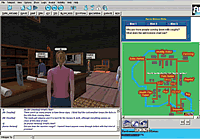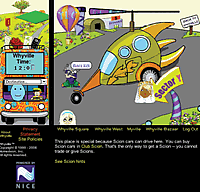Educational Gaming :: All the Right MUVEs
##AUTHORSPLIT##<--->
The use of computer simulations that appealto students’ love of video games has showncompelling educational benefits.  IF YOU ONLY PUT A FRACTION OF THAT TIME AND ENERGY INTO YOUR STUDIES, YOU’D BE A STRAIGHT-A STUDENT!
IF YOU ONLY PUT A FRACTION OF THAT TIME AND ENERGY INTO YOUR STUDIES, YOU’D BE A STRAIGHT-A STUDENT!
It’s the universal cry of parents the world over, driven mad by the persistent sight of their children investing hours and hours in mastering the many layers of a video game. To the parent, video games are the enemy, the nemesis of homework and learning. But the child sees something of value, something engaging enough to fill a weekend, to the exclusion of all other activities. What might happen if, instead of being fuel for a concerned- parent (and teacher) vs. recalcitrant-child conflict, the technology that so enthralls young people were used not for slash-and-burn computer games, but for educational purposes?
Some innovative educators think they know the answer: reduced absenteeism, increased concentration, enhanced learning, faster development of the skills that are needed in today’s high-tech society—and students eager for more. On the internet and in school classrooms, students, teachers, and administrators are beginning to discover that what looks like a video game—a “MUVE”—can offer much more than just entertainment.
What’s a MUVE?
Basically, a MUVE (multi-user virtual environment) is an interactive computer simulation of a geographical area, say a town, where features of the environment— buildings, rivers, stairways, people—are represented by computer graphics.
Virtual environments have been around a long time. “You’re in a twisty maze of passageways, all alike” is a wellremembered line from the original interactive MUVE, Adventure. Responding to textual descriptions of locations in the Colossal Cave—the game had no graphics— players would type instructions such as “Go left,” “Go right,” or “Pick up lamp” to lead an imaginary adventurer through the chambers of the cave and its surroundings, collecting prizes and dealing with hazards along the way.
New technology has taken modern MUVEs a good deal further. A player now uses a mouse to lead an avatar into a building, up a flight of stairs, or across a bridge—passageways to even more options. Other characters may materialize. If you enter a store, for example, a salesclerk might appear and ask you what you would like to buy. In a typical video game, the supporting characters are enemies that attack your avatar. In an educational MUVE, these characters are used to answer questions or give you information about your location. Therein is the critical difference between video games and MUVEs: Both take their avatars on explorations, but they have different notions of success. With MUVEs, instead of warding off opponents, searching for gold, or racking up points, players have only one goal: learning.
River City
One of the leading educational MUVEs is the River City Project, a program created by a group of professors from several universities and implemented by about 60 teachers for 4,000 students in the US and Australia.

VIRTUAL REALITY In River City, students
must gather data to determine the source of
a health crisis and then suggest a remedy.
To use River City, students in a classroom collaborate in teams of three, with every student using a PC linked to a LAN where River City has been installed. Each student controls an avatar placed in a simulated American river town in the late 1800s. The town is facing a health crisis, and the students’ goal is to find out why the residents of River City are getting sick and what can be done to help them. To that end, students can interact with residents, view archival photos from the Smithsonian Institute, and gather data with virtual tools such as microscopes and bug catchers, then they can share their findings with their teammates. If the teacher activates the chat feature, the student teams can interact with each other electronically. Students can also see the avatars of users from other schools, but for safety’s sake, the program allows them to communicate only with their classmates.
The story line grew out of work the program’s Harvard University (MA)- based development team did with teachers from Bostonarea schools. The teachers identified a key problem: They needed a way to help students understand how to identify a problem, create a hypothesis, then test it. The researchers took heed, and with River City, created a MUVE to address those concerns. The students’ first task is to gather data in order to understand what is causing the outbreak of illness. There are lots of ways to gather data. The students can move around the city, listening for clues such as a mosquito buzzing. They can go to the local hospital and see who has been admitted, with what symptoms and from what part of town. They can gather water and check it for bacteria, or collect mosquitoes and see where they are most prevalent. One key element of their investigation is interviewing River City residents, which means they must enter queries that will yield the data they need to work out a solution. In the end, after about 20 class periods (15 hours in all), the students each write a letter to the mayor of River City with advice on how to address the situation.
River City also offers a lot of biology and ecology content, chosen in accordance with the National Science Standards. The program uses three variations of simulated disease transmission: waterborne, airborne, and insect-borne. The three strands are coordinated with content about history, social interaction, and geographical factors so students have to deal with multiple causes and issues to arrive at the most appropriate remedy. Another focus of the River City curriculum is the development of collaborative skills, which is facilitated by having the students work in teams. In the final stage of the program, the teams compare their work to see the range of hypotheses and causal relationships that can be derived.
Making an Impact
So what effect does River City have on students? In “Students’ Motivation and Learning of Science in a Multi-User Virtual Environment” (available at the River City website), the Harvard team, led by Principal Investigator Chris Dede, a Harvard professor of learning technologies, presents its findings. Laying out their intentions, the authors state that “a major goal for education in the 21st century is to create scientifically literate citizens who are able to think critically, make sense of complex data, and solve problems,” and that the“River City curriculum focuses on skillsof hypothesis formation and experimentaldesign.”
NOT ALL FUN AND GAMES

Though the benefits of educational MUVEs are apparent, the technology has its challenges.
Test data showing increased learning and enhanced student engagement should do much to address the natural skepticism parents and administrators have about the use of MUVEs in school, but there are other barriers to overcome.
For example, Whyville allows young people to chat about educational projects with their peers throughout the world, which is a powerful advantage for Whyvillians, but can be a concern for their parents.“I had two parents who asked that their children not be able to chat or useWhymail,” says educational consultant Cathleen Galas, a former sixth-gradeteacher who used Whyville at the University Elementary School, which isattached to the UCLA Graduate School of Education & Information Studies.She adds that the parentssoon changed their minds.
Whyville has strict controls built into its chat and Whymail functions: Giving out passwords, direct e-mail or instant message addresses, or personal information such as school names is strictly forbidden. Most profanity is automatically filtered out by the system, and a warning is sent to those who attempt to enter it in chat windows.
“We’ve spent a lot of time and energy on that,” says Jen Sun, president of Numedeon, the creator of Whyville. “In eight years of operation, we’ve never had a real problem.” Children under the age of 13 must have their parents fax or mail in a signed permission form in order to be able to chat in Whyville.
Access to technology can also be a challenge. “Not every kid has a computer at home,” Galas acknowledges. “It’s very important for teachers to help those students find their way to the public libraries or the school computer lab.” Elizabeth Perry, technology integrations specialist at The Ellis School, an all-girls school in Pittsburgh, cites professional development as another factor. Perry says that training teachers on integrating MUVEs into the curriculum and helping them adapt their teaching style is vital. “Faculty development time,” she says, “is at least as important as equipment, if not more so.”
In 2004-2005, the researchers worked with 11 teachers and more than 1,000 students in the Boston and Milwaukee areas, and tests were administered to measure specific content knowledge in biology, computer skills, ability to formulate inquiries, enjoyment of science, and knowledge of scientific process. The tests showed that after using River City for 20 class periods, students showed a 32 to 35 percent improvement in their knowledge of biology. Analyzing the letters the students wrote to the mayor of River City, the researchers found that “students demonstrate an understanding of the process of inquiry,” and that “both lowand high-performing students demonstrated a clear causal relationship between the problem and the reason(s) for the problem.” The report also notes two other significant outcomes. In one classroom, where attendance had been a major problem before River City was introduced, the teacher saw a 35 percent decrease in absenteeism from the first to the last week of the project. In the post-program evaluations, teachers and students both asked to use the program again.
During Whyville’s data-collection phase, Cathleen Galas’ sixth-graders wanted to meet in the evenings to complete the work. Galas didn’t seem to mind: "What a great problem for a teacher to have."
Diane Jass Ketelhut, the project’s former director of research and now assistant professor of science education at Temple University (PA), says, “Parents reported that their children were coming home and telling them all about River City at the dinner table. They were impressed not just with what they were hearing, but that their middle school children were telling them about it.”
Next Stop: Whyville
Cathleen Galas had a similar positive experience with MUVEs. Galas, now an educational consultant, taught sixth grade at the University Elementary School (the laboratory school for the UCLA Graduate School of Education& Information Studies),where she used River City andWhyville. Unlike River City,which runs on a closed LAN,Whyville is accessed through theinternet.Whyville is a virtual metropolis,with its own newspaper, government,suburbia, and economy.
In 2003, Galas worked with researchers at Whyville’s manufacturers, Numedeon, to help her teach epidemiology. Numedeon created a program in Whyville for use by Galas’ class wherein some participants could catch“whypox,” which left the avatar’s facegray and covered with spots. The goal wasto teach students about how diseasesspread; the program was a major hit.
“I had students say, ‘Please! Assign us homework tonight!’” Galas recalls. “‘If you assign it as homework, my parents will let me go online.’ Some of my students asked me if they could stay in for recess or come in before or after school.” Since Whyville allowed for after-school online meetings, class time could be extended; Galas’ students themselves made the request. During the data-collection phase, she says they asked to meet in the evenings: “We can’t just leave it like this, we can’t wait until tomorrow. Let’s meet tonight at 6!” While acknowledging that it meant a bit of extra time for her, Galas didn’t seem to mind: “What a great problem for a teacher to have.”
Whyville offers a variety of sciencebased activities designed to be fun and to emphasize process over rote learning of facts. Nearly all of its users, or Whyvillians, log in from home or public libraries, though some teachers are beginning to make use of the site directly from the classroom or school computer lab.
One popular feature is a dance design studio, where the children begin by tracing the steps of some actual dances. The basis for the activity is learning about vector arithmetic, so that once students learns how the vectors work, they can design their own dances. “We got a nice letter from a girl who designed her own dance but didn’t realize that this was vector arithmetic until she encountered it in school,” says Numedeon President Jen Sun. “She perked up and told her math teacher, ‘Oh, I know what this is! This is Mimi’s Dance Studio!’”

WHO,WHAT, AND WHYVILLE The Whyville
site has many science-oriented educational
features for Whyvillians to choose from.
The Teacher as Guide
Using a MUVE in class transforms the teacher’s customary role of providing answers into one of providing questions. As Sun says, “When you use a MUVE in a classroom, the teacher’s role is much more of a guide, a part of the inquiry process rather than an answergiver.” Sun says teachers have to adjust to “thinking in a different way” to encourage their students to ask questions by starting off the lesson with questions of their own “rather than beginning with definitions.”
Galas agrees. “To use MUVEs effectively,” she says, “teachers need to be skilled in facilitating discussion—creating and sustaining student-centered classroom inquiry—to assist students in learning to ask good questions and to collaborate in teams. This kind of teaching truly demands more of teachers. They need to be supported, not only in learning how to teach this way and understanding the value of this pedagogical approach, but also in having time to gather resources so that when the students are ready, the teacher is ready too.”
Decentralizing the role of the teacher alters the students’ role in their own education as well. Galas says one benefit of using MUVEs is that students“learn how to learn. In traditional classrooms,where the teacher is supposed tobe the fountain of knowledge, kidseither get it or they don’t. And if theydon’t, they think they’re stupid and turnoff. In a MUVE, they can ask questionswithout penalties, and this actuallyaffects the classroom environment forthe better.”
Elizabeth Perry, technology integrations specialist at The Ellis School in Pittsburgh, where a MUVE that has students investigate an ancient shipwreck is being used to augment the science curriculum, says that “MUVEs can help students think critically and analyze and construct new knowledge for themselves. These experiences may present the challenge of a less teacher-centered classroom, but as the students become more responsible for their own learning, and as they draw on the collaborative strength of group work at its best, we find unexpected leaders emerging from the process.”
MUVE-ing Into the Future
The progression from the early days of Adventure to the present day of Whyville and River City shows that as gaming technology evolves, more horsepower will be available for education. Advancements are sure to come now that companies such as Activeworlds are developing tools for creating virtual worlds and environments, freeing educational content makers to focus on the substance of their programs rather than the underlying technology. (River City is based on the Activeworlds toolset.)
We got a nice letter from a girl who designed her own dance but didn’t realize that this was vector arithmetic until she encountered it in school. She perked up and told her math teacher, 'Oh, I know what this is! This is Mimi’s Dance Studio!'
Jen Sun, Numedeon
The proliferation of computers and broadband access into homes may mean that the dividing line between classwork and homework will blur. “Some kids can do a thing once and get it,” Galas says. “Others need to do it over and over again before all of a sudden, the lightbulb comes on and they say, ‘I’ve got it!’ That’s what’s wonderful about the technology, that students can do exercises as many times as they like on their own timeline. They’re all able to learn; they just need the tools.”
Galas says the enthusiasm of her students was inspiring. “When they get that excited about learning, you can do more than you ever thought possible. You’ve got them.”
:: web extra :: For more information on this topic, visit www.thejournal.com. In the Browse by Topic menu, click oneLearning/Web.
Mikael Blaisdell is principal of an IT support consultancy, Mikael Blaisdell & Associates, serving higher education and corporations worldwide.